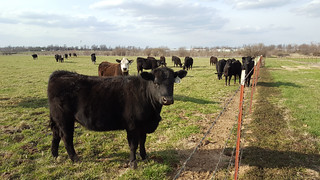Select suitable grazing method to assure success
April 12, 2018
Fast Facts:
- Most common methods are continuous stocking and rotational stocking
- Grazing methods aim to remove forage at manageable rate
(344 words)
Related PHOTO available for download: https://flic.kr/p/264HjW4
FAYETTEVILLE — Selecting a grazing method early in the season and managing it properly can help beef producers succeed in achieving their summer production goals, said Dirk Philipp, associate professor of animal science and forage researcher for the University of Arkansas System Division of Agriculture.

“A grazing method should not be confused with a grazing system,” Philipp said. “A grazing method is a defined technique of grazing management designed to achieve a desired outcome in forage removal.”
The two most common examples of grazing methods, Philipp said, are continuous stocking and rotational stocking.
In continuous stocking, animals are kept always on the same area, Philipp said. It’s an easy and uncomplicated setup, useful when producers have time constraints or lack funds to invest in a more complex paddock setup. It’s also useful when there are insufficient fences or water sources to permit subdivision of grazing lands.
Continuous stocking can be used when available forage can withstand occasional overgrazing in some areas. Forages like toxic fescue and bermudagrass are persistent enough to endure such conditions, Philipp said.
Avoid using continuous stocking when:
- Forage base is sensitive to frequent defoliation, as is the case with legumes;
- Intending to portion out forages, especially in high-quality forages like alfalfa;
- Grazing annual forages for which money and time was invested.
Rotational stocking offers more control of forage use and defoliation, Philipp said. It is also more suitable for a solid, long-term forage management plan.
Some things to consider for a rotational stocking method, Philipp said, include adequate fences and water access, or a plan to install them.
Consider planting forages that benefit from cyclical defoliation, Philipp said. Novel endophyte tall fescue, native warm-season grasses or legumes are good choices. Forages with large regrowth potential, such as cool season grasses early in the season, are also suitable for use in rotational stocking, he said.
Philipp said rotational stocking is difficult to use if:
- The basic paddock infrastructure is not installed;
- Budgets aren’t controlled or inputs and outputs aren’t accounted for;
- A long-term business and forage management plan is not in place.
About the Division of Agriculture
The University of Arkansas System Division of Agriculture’s mission is to strengthen agriculture, communities, and families by connecting trusted research to the adoption of best practices. Through the Agricultural Experiment Station and the Cooperative Extension Service, the Division of Agriculture conducts research and extension work within the nation’s historic land grant education system.
The Division of Agriculture is one of 20 entities within the University of Arkansas System. It has offices in all 75 counties in Arkansas and faculty on five system campuses.
Pursuant to 7 CFR § 15.3, the University of Arkansas System Division of Agriculture offers all its Extension and Research programs and services (including employment) without regard to race, color, sex, national origin, religion, age, disability, marital or veteran status, genetic information, sexual preference, pregnancy or any other legally protected status, and is an equal opportunity institution.
By Fred Miller
Arkansas Agricultural Experiment Station
U of A System Division of Agriculture
Media Contact: Fred Miller
U of A Division of Agriculture
(479) 575-5647
fmiller@uark.edu
Related Links